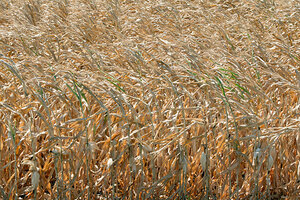As drought withers US corn crop, ethanol industry feels the squeeze
As corn prices soar amid deepening drought, ethanol plants watch their margins evaporate. The industry is working at half-capacity, and some plants have closed. The slowdown is a blow to some rural areas.

Dried corn plants stand in a field near Mead, Neb., Thursday, Aug. 9.
Nati Harnik/AP
Chicago
In late June, as drought gripped his state, Tom Utley saw a sign of trouble. The plume of steam that had billowed 24 hours a day high above the local ethanol plant – and fixed the location of his town from far across the fields of central Indiana – had vanished.
“I think everyone in the community notices when stream is not coming out of the stack,” says Mr. Hutley, a resident of Linden, Ind., and county commissioner for Montgomery County. “It’s a reminder every day that something is amiss in ethanol land.”
The drought that has shrunken rivers and withered crops in much of the United States has begun to take a wider economic toll. A recent survey of Midwestern bankers in 10 states found declining retail sales, slowing equipment purchases, and increased borrowing, among other indicators.
“The numbers are not nearly as good as they’ve been,” says Ernie Goss, an economist at Creighton University in Omaha who surveyed bankers for the Rural Mainstreet Index.
The economic slowdown has extended to the ethanol business, which blossomed in recent years and now consumes about 40 percent of the nation’s corn crop. Drought-inflicted damage to the corn crop has driven up corn prices – now about $8 a bushel – and squeezed ethanol margins to the vanishing point, say agricultural economists and industry experts. As a result, many ethanol plants have cut production. In a few places, plants have shut down entirely.
“The price of corn got so high and the price of ethanol didn’t rise fast enough, that these plants were losing money on every gallon of ethanol we made,” says Bill Day, a spokesman for Valero Energy Corp. Valero, a petroleum refining company based in San Antonio, Texas, has closed two of its 10 ethanol plants, including the one in Linden. Overall the company’s plants are working at 50 percent of capacity. So far, Mr. Day says, Valero has not been forced to lay off any ethanol plant workers.
With 211 plants in 27 states, the ethanol industry produced 13.9 billion gallons in 2011. According to the Renewable Fuels Association, a trade organization based in Washington, ethanol production is down about 13 percent since early June.
“You’ve seen some pretty dramatic curtailing in ethanol production,” says Matt Hartwig, a spokesman for the association.
It’s a significant setback for an industry that until recently was thriving. Ethanol production had been rising, thanks to a strong export market and a federal mandate that requires petroleum companies to blend ethanol in their gasoline. Last year ethanol plants were spending millions of dollars to expand plants, make improvements, and invest in allied businesses, like fish and shrimp farms, which use some of the byproducts of the ethanol-making process, says Todd Sneller, administrator for the Nebraska Ethanol Board, a public agency that promotes ethanol.
“It was really evident there was a lot of cash around,” he says.
Now, plants in Nebraska, the second largest ethanol-producing state, have cut production between 20 and 30 percent, says Mr. Sneller, and the Ethanol Board is getting calls from investors looking for “distressed” plants to buy.
But many more people in rural communities are keeping an eye on the industry’s slowdown.
“Broadly, it creates uncertainty across the rural landscape,” says Chad Hart, an economist at Iowa State University in Ames. “Ethanol was seen as one of those industries that was reinvigorating rural communities ... bringing some economic activity back to the countryside, helping to hold people in rural areas.”
The difficulties for the ethanol industry also come as the federal ethanol mandate falls under increased attack. Livestock farmers and the meat industry want the US Environmental Protection Agency to suspend the mandate, arguing that it is driving up the price of corn and squeezing ranchers and other farmers who buy corn to feed their chickens, pigs, and beef cattle.
Agricultural economists say that suspending the mandate may not make much of a difference in either ethanol production or the price of corn. Indeed, last year’s production exceeded the mandate.
Drought is not the only factor affecting the ethanol business. Ethanol prices are low in part because petroleum companies stockpiled ethanol last year. Meanwhile, demand for gasoline has ebbed because of the worldwide economic slowdown and improved fuel efficiency in the US.
The ethanol industry has endured difficult times before. In 2008, some ethanol plants went bankrupt when the price of corn spiked. “I think most ethanol producers learned some lessons in 2008,” says Mr. Hartwig.
Economists expect the current slowdown to be temporary and business to revive as inventories shrink and ethanol prices rise. Chris Hurt, an agricultural economist at Purdue University, in Lafayette, Ind., says margins seem already to have improved. In late June and early July, he says, plants were losing about 70 cents for every bushel of corn they turned into ethanol. Today, he says, they’re closer to the break-even point. And as Kyle Phillips, an Iowa corn grower who has invested in three ethanol plants, says, “Next year’s another year.”
Still, estimates of this year’s corn crop continue to disappoint. With new Agriculture Department figures coming out Friday, Mr. Hurt says the US corn crop is likely to have decreased 20 to 22 percent from earlier expectations.
“Anybody that uses corn is worried,” he says.

